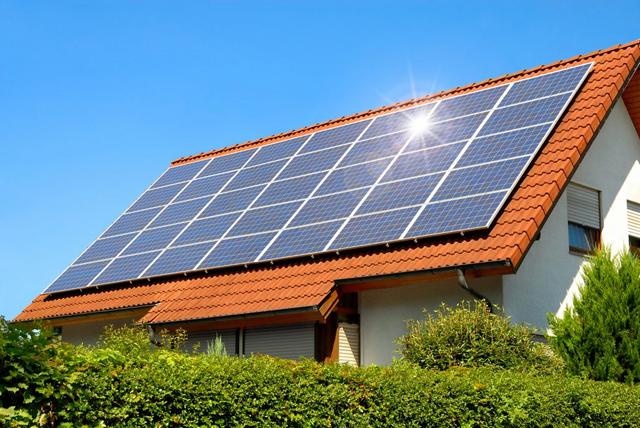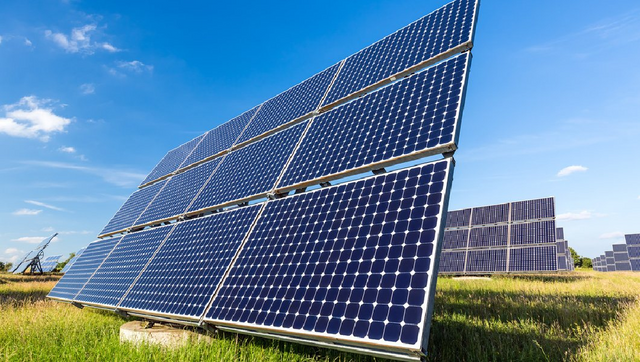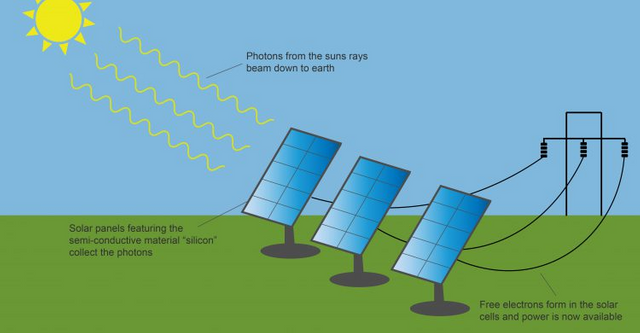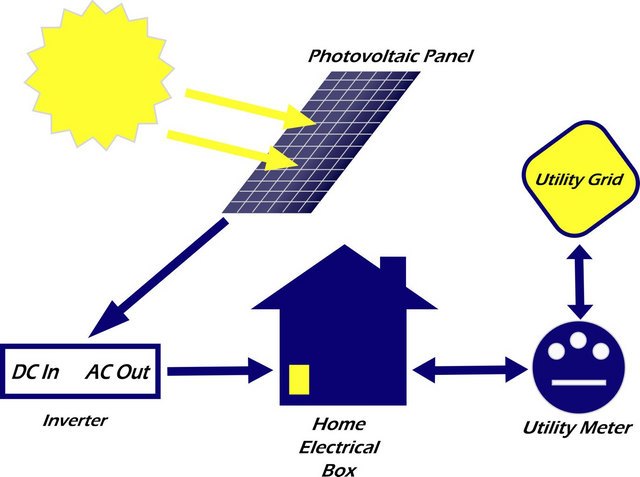How to make and install solar panels ourselves
For more than one decade humanity has been looking for alternative energy sources that can at least partially replace existing ones. And the most promising of all today are two: wind and solar power. True, neither one nor the other can provide continuous production. This is due to the volatility of the wind rose and the daily-weather-seasonal variations in the intensity of the solar stream. Today's power engineering offers three basic methods for obtaining electrical energy, but all of them in one way or another are harmful to the environment:
- Fuel electric energy is the most environmentally dirty, accompanied by significant emissions of carbon dioxide, soot and useless heat into the atmosphere, causing a reduction in the ozone layer.
- Extraction of fuel resources for it also causes significant damage to nature. Hydropower is associated with very significant landscape changes, flooding of useful land, causing damage to fish resources.
- Nuclear power is the most environmentally friendly of the three, but it requires a very high cost of maintaining safety. Any accident can be associated with causing irreparable long-term damage to nature. In addition, it requires special measures for the utilization of waste fuel.
Solar battery - what is it?
Strictly speaking, it is possible to obtain electricity from solar radiation in several ways, but most of them use its intermediate conversion to a mechanical, rotating shaft of the generator and only then to the electric one.
Such power plants exist, they use Stirling's external combustion engines, they have good efficiency, but they also have a significant disadvantage: in order to collect as much solar energy as possible, it is necessary to produce huge parabolic mirrors with systems for monitoring the position of the sun.
I must say that there are solutions to improve the situation, but they are all quite expensive.
There are methods that enable direct conversion of light energy into electric current. And although the phenomenon of the photoelectric effect in semiconductor selenium was discovered already in 1876, but only in 1953, with the invention of a silicon photocell, a real possibility of creating solar batteries for generating electricity appeared.
At this time, a theory has already appeared that made it possible to explain the properties of semiconductors and to create a practical technology for their industrial production. By today, this has resulted in a real semiconductor revolution.
The work of the solar battery is based on the phenomenon of the photoelectric effect of a semiconductor p-n junction, which is essentially a conventional silicon diode. At its conclusions, under illumination, a photographic emf of 0.5 ~ 0.55 V appears.
Structurally, each element of the solar battery is made in the form of a silicon plate several cm2 in area, on which a plurality of connected photodiodes are connected in a single circuit. Each such plate is a separate module, giving a certain voltage and current under sunlight.
By connecting such modules to the battery and combining their parallel-serial connection, a wide range of output power values can be obtained.
Advantages and disadvantages of this type of energy
The main disadvantages of solar batteries:
- large unevenness and irregularity of energy output depending on the weather, and the seasonal height of the sun.
- Limit the power of the entire battery, if at least one part of it is shaded.
- Dependence on the direction of the sun at different times of the day. To maximize the use of the battery, it is necessary to ensure its constant directionality in the sun.
- In connection with the foregoing, the need for energy storage. The greatest energy consumption comes at a time when production is minimal.
- The large area required for a design of sufficient power.
- The fragility of the battery design, the need for constant cleaning of its surface from contaminants, snow, etc.
- Solar battery modules work most efficiently at 25 ° C. During operation, they are heated by the sun to a much higher temperature, greatly reducing their effectiveness. To maintain the efficiency at the optimum level, it is necessary to provide cooling of the battery.
It should be noted that the development of solar cells using the latest materials and technologies is constantly emerging. This allows you to gradually eliminate the shortcomings inherent in solar panels or reduce their impact. So, the efficiency of the newest elements using organic and polymer modules reaches 35% already and there are expectations of reaching 90%, and this makes it possible to obtain much greater power with the same dimensions of the battery, or, saving energy, significantly reduce the size of the battery.
By the way, the average efficiency of an automobile engine does not exceed 35%, which allows us to speak about the rather serious efficiency of solar panels.
There are developments of elements on the basis of nanotechnology, equally efficiently working under different angles of incident light, which eliminates the need for their positioning.
Thus, today we can speak about the advantages of solar batteries in comparison with other energy sources:
- The absence of mechanical transformations of energy and moving parts.
- Minimum operating costs.
- Durability 30 ~ 50 years.
- Silence at work, no harmful emissions.
- Ecological compatibility. Mobility. Battery to power the laptop and charge the battery for the LED flashlight fits perfectly in a small backpack.
- Independence from the presence of constant current sources. The ability to recharge batteries of modern gadgets in the field.
- Low demand for external factors. Solar cells can be placed anywhere, on any terrain, if only they are sufficiently illuminated by sunlight.
Design features
In the equatorial regions of the Earth, the mean solar energy flux averages 1.9 kW / m2. In the central strip of Russia, it is in the range 0.7 ~ 1.0 kW / m2. The efficiency of a classical silicon photocell does not exceed 13%.
As the experimental data show, if the rectangular plate is directed with its plane to the south, to the point of the solar maximum, then within 12 hours of a sunny day it will receive no more than 42% of the total luminous flux due to a change in its angle of incidence.
This means that with an average solar flux of 1 kW / m2, 13% of the efficiency of the battery and its total efficiency of 42% can be obtained in 12 hours no more than 1000 x 12 x 0.13 x 0.42 = 622.2 Wh, or 0, 6 kWh per day with 1 m2.It is subject to a full sunny day, in cloudy weather - much less, and in winter months this value should be divided by another 3.
Taking into account the losses for the voltage conversion, the automatic circuit providing the optimal charging current of the batteries and protecting them from overcharging, and other elements can be taken as the basis of the figure of 0.5 kWh / m2. With this energy it is possible to maintain the current of the battery charge 3 A for 13 hours at a voltage of 13.8 V.
That is, to charge a fully discharged car battery with a capacity of 60 Ah, you need a solar panel of 2 m2, and for 50 Ah - about 1.5 m2.
In order to get this power, you can buy ready-made panels that are produced in the range of electric capacities of 10 ~ 300 W. For example, one 100 W panel for a 12-hour light-day with a coefficient of 42% will just provide 0.5 kWh.
Such a panel of Chinese production made of single-crystal silicon with very good characteristics is now on the market about 6400 r. Less effective in the open sun, but having better returns in cloudy weather polycrystalline - 5000 r.
If you have certain skills in installing and soldering radio electronic equipment, you can try to assemble a similar solar battery yourself. In this case, you should not expect a very large gain in the price, in addition, the finished panels have the factory quality of both the elements themselves and their assembly.
But the sale of such panels is organized far from everywhere, and their transportation requires very harsh conditions and will be quite expensive. In addition, when self-made, it becomes possible, starting with small, gradually add modules and increase output power.
Selection of materials for the creation of the panel
In many online stores, as well as at the auction eBay offers a wide selection of elements for the self-manufacturing of solar cells with any parameters.
In the not too distant past homebuilders purchased plates that were rejected during production, having chips or other defects, but much cheaper. They are quite workable, but have a slightly lower power return. Given the constant decline in prices, now it is hardly advisable. After losing an average of 10% of the capacity, we are losing in the effective area of the panel. Yes, and the appearance of a battery consisting of plates with chipped pieces looks quite handicraft.
Advice: It should be taken into account that the elements are very fragile and some of them may be damaged during transportation, therefore, when ordering, some reserve should be provided for their quantity.
Making a solar battery for a house with our own hands.
To produce a solar panel, we need a suitable frame, which can be done by yourself or pick up the finished one. Of the materials for it is best to use duralumin, it is not susceptible to corrosion, is not afraid of dampness, is durable. With appropriate processing and painting for protection from the atmospheric precipitation, it is suitable for steel and even wooden.
Tip: Do not make a very large panel: it will be inconvenient to install elements, install and maintain. In addition, small panels have a low sail, they can be conveniently placed at the required angles.
How to calculate the components
Let's determine the size of our frame. To charge a 12-volt acid battery requires an operating voltage of at least 13.8 V. We take 15 V as a basis. To do this, we have to connect in series 15 V / 0.5 V = 30 elements.
Tip: The output of the solar panel should be connected to the battery via a protective diode in order to avoid its self-discharge in the dark through solar cells. So at the output of our panel will be: 15 V - 0.7 V = 14.3 V.
To obtain a charging current of 3.6 A, we need to connect three such chains in parallel, or 30 x 3 = 90 elements.
Tip: The elements of the solar panel are connected in parallel-in series. It is necessary to observe the equality of the number of elements in each successive chain.
With this current, we can provide a standard charge mode for a fully discharged battery with a capacity of 3.6 x 10 = 36 Ah.
Really, this figure will be less because of uneven sunlight throughout the day. Thus, to charge a standard car battery of 60 Ah, we will need to connect two such panels in parallel.
This panel can provide us with an electrical power of 90 x 0.62 W ≈ 56 W.
Or during a 12-hour sunny day with a correction factor of 42% 56 x 12 x 0.42 ≈ 0.28 kWh.
We will place our elements in 6 rows of 15 pieces. To install all the elements we need a surface:
- Length - 15 x 52 = 780 mm.
- Width - 77 x 6 = 462 mm.
For the free placement of all the plates we take the dimensions of our frame: 900 × 500 mm.
Tip: If there are finished frames with other dimensions, you can count the number of elements in accordance with the above nametki, pick up the elements of other sizes, try to place them, combining the length and width of the rows.
Also we will need:
- Soldering iron electric 40 W.
- Solder, rosin.
- Mounting wire.
- Silicone sealant.
- Double sided tape.
Stages of manufacture
For panel mounting, it is necessary to prepare an even work area of sufficient size with a convenient approach from all sides. The plate elements themselves are best placed separately in the side, where they will be protected from accidental shocks and falls. Take them carefully, one at a time.
Usually, the panel is made using a method of gluing pre-loosened elements into a single chain of plates on a flat substrate substrate. We offer another option:
- We insert into the frame, secure and seal the edges of the glass or a piece of plexiglas.
- We lay out on it in the appropriate order, gluing them with a double-sided tape, the plates of the elements: the working side to the glass, the soldering leads to the back side of the frame.
- Putting the frame on the table with the glass down, we can conveniently undo the findings of the elements.
- We perform electrical installation in accordance with the selected circuit diagram of the inclusion.
- We glue the plates completely on the back side with adhesive tape. We put any damping gasket: sheet rubber, cardboard, fiberboard, etc.
- We insert the rear wall into the frame and seal it.
If desired, instead of the rear wall, you can pour the frame from behind with some compound, for example, epoxy.
However, this will already exclude the possibility of dismantling and repairing the panel.
Scheme connecting the electricity supply of the house using our batteries
Of course, one battery of 50 watts is not enough to provide energy even a small house. But with its help it is already possible to realize lighting in it, using modern LED lights.
For a comfortable existence of a city resident, at least 4 kWh of electricity is required per day. For the family, according to the number of its members.
Consequently, the solar battery of a private house for a family of three people should provide 12 kWh. If we are going to provide electricity for the home only from solar energy, we need a solar battery with an area of at least 12 kWh / 0.6 kWh / m2 = 20 m2.
This energy must be stored in rechargeable batteries with a capacity of 12 kWh / 12 V = 1000 Ah, or about 16 batteries of 60 Ah.
For the battery to work properly with the solar panel and its protection you need a charge controller. To convert 12 V DC to 220 V AC, you need an inverter.
Although now the market is already in sufficient quantities of electrical equipment at a voltage of 12 or 24 V.
Tip: In low-voltage power networks, currents of significantly higher values operate, therefore, to conduct wiring to powerful equipment, a wire of the appropriate cross section should be selected. Wiring for networks with the inverter is carried out according to the usual scheme of 220 V.
Drawing conclusions
With the accumulation and rational use of energy, today unconventional types of electric power industry are beginning to create a solid increase in the total amount of its production. You can even say that they are gradually becoming traditional.
Considering the recently decreased energy consumption level of modern household appliances, the use of energy-saving lighting devices and the significantly increased efficiency of solar panels of new technologies, we can say that they are already able to provide electricity to a small private house in southern countries with a large number of sunny days a year.
They can be used as backup or additional energy sources in combined power supply systems, and if their efficiency can be increased to at least 70%, then their use as the main electricity suppliers will be realistic.

Support @steemstem and the #steemstem
project - curating and supporting quality STEM
related content on Steemit






Solar energy definetly is future. Good post.
The future is definitely going to be on Solar power or something even better than this. I live in a country (India) where we get lots of light/energy from sun, yet the Government doesn't understand about the importance of this technology and the growth has been a bit slow here. A very detailed post indeed. Keep up your good work. :)
This post has received a 0.30 % upvote from @booster thanks to: @techlife.
This post has received a 0.53 % upvote from thanks to: @techlife.
thanks to: @techlife.
For more information, click here!!!!
Send minimum 0.100 SBD to bid for votes.
Before sending a transfer to @minnowhelper, verify that your publication meets these conditions (http://www.minnowhelper.com/conditions.php). After the transfer is made, no claims will be received.
The Minnowhelper team is still looking for investors (Minimum 10 SP), if you are interested in this, read the conditions of how to invest click here!!!
ROI Calculator for Investors click here!!!
Congratulations! This post has been awarded a 100% upvote by @lottobot! This post was the winner of lottery #1248, which had a total of 1 entries. @lottobot always has a lottery going on! If you would like to nominate a post for the current lottery, just send 0.1 SBD or STEEM to @lottobot, and include the url of the post you would like to nominate as a memo. Learn more by reading the introductory post! Good luck!
Solar and wind are good energy sources, but they are not the best and won't be the future. Zero Point Energy will. Nikola Tesla is a name that is not commonly known. If the name is known, seldom is his work. If all of his amazing technology was incorporated in our societies the world would be a completely different place. Nikola Tesla and countless others after him created technology that could harness and distribute unlimited energy. Some of these devices didn't even have moving parts, which would lead to it not breaking down. Contrary to belief we do not understand electricity. We don't even have proof that an electron exists.
For example: When Nikola Tesla was in the US he created the Wardenclyffe Tower which would harness energy from the ionosphere and distribute it wirelessly for miles. As long as you were within the radius of the tower you had unlimited, free energy. Tesla was being financed by J.P. Morgan who asked where the meter would be put to charge the people. Tesla replied that it would be free to all... You can see why it was destroyed and hidden.
^^^Nikola Tesla in his lab holding a bulb that is being lit by wireless energy.
A lot of people keep trying to make o-energy engine designs, but it seems a lot of them need a little help to maintain centrifugal force. Why not both?
Some do, yes. Most don't. There is/was a fellow by the name Steven Mark that created a device with no moving parts that would produce unlimited energy with no primer(in the conventional sense) to initiate or to maintain. It uses the Earth's electromagnetic field as an energy supply which it converts to something usable by our electrical items.
I sort of wonder why Solar Panels don't have a magnifying glass dome that can help capture more sun from all angles, and focus it to one epicenter.
I've been wondering how to make a solar system after hearing how you can make a "Wall" of computer batteries, but I sort of want to create a minimalistic approach and see what works to improve it. This post is a great wealth of information. Thank you!
I think solar panels would perfectly work in caribean countrys, like in Venezuela. Thank you for the info! Good post.